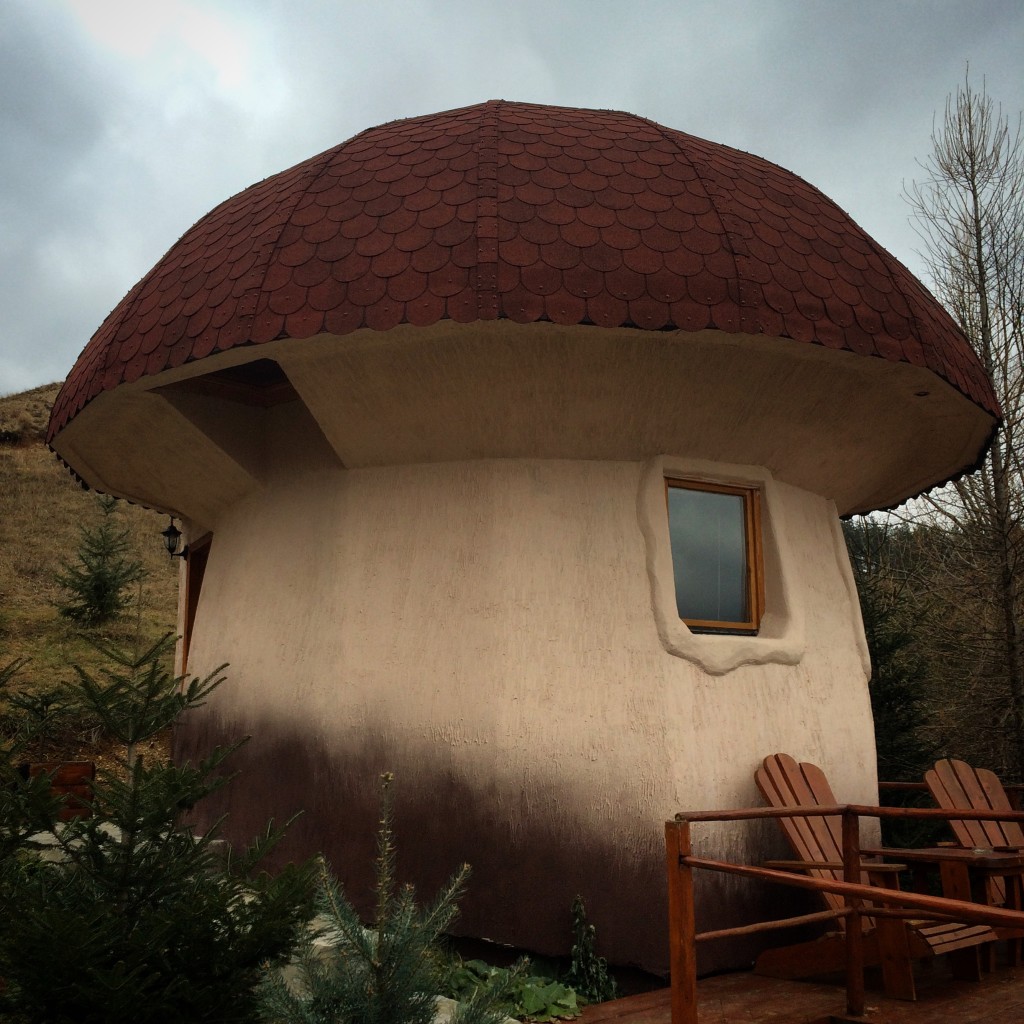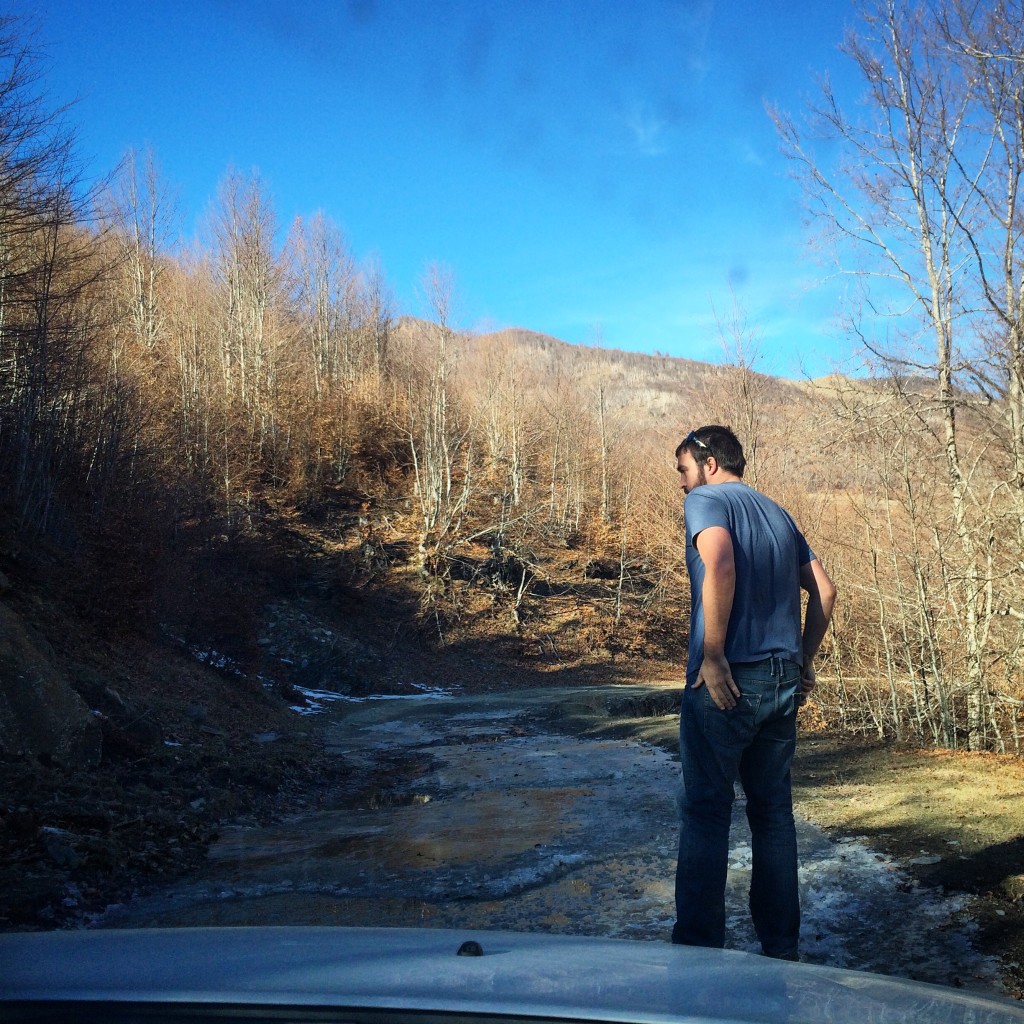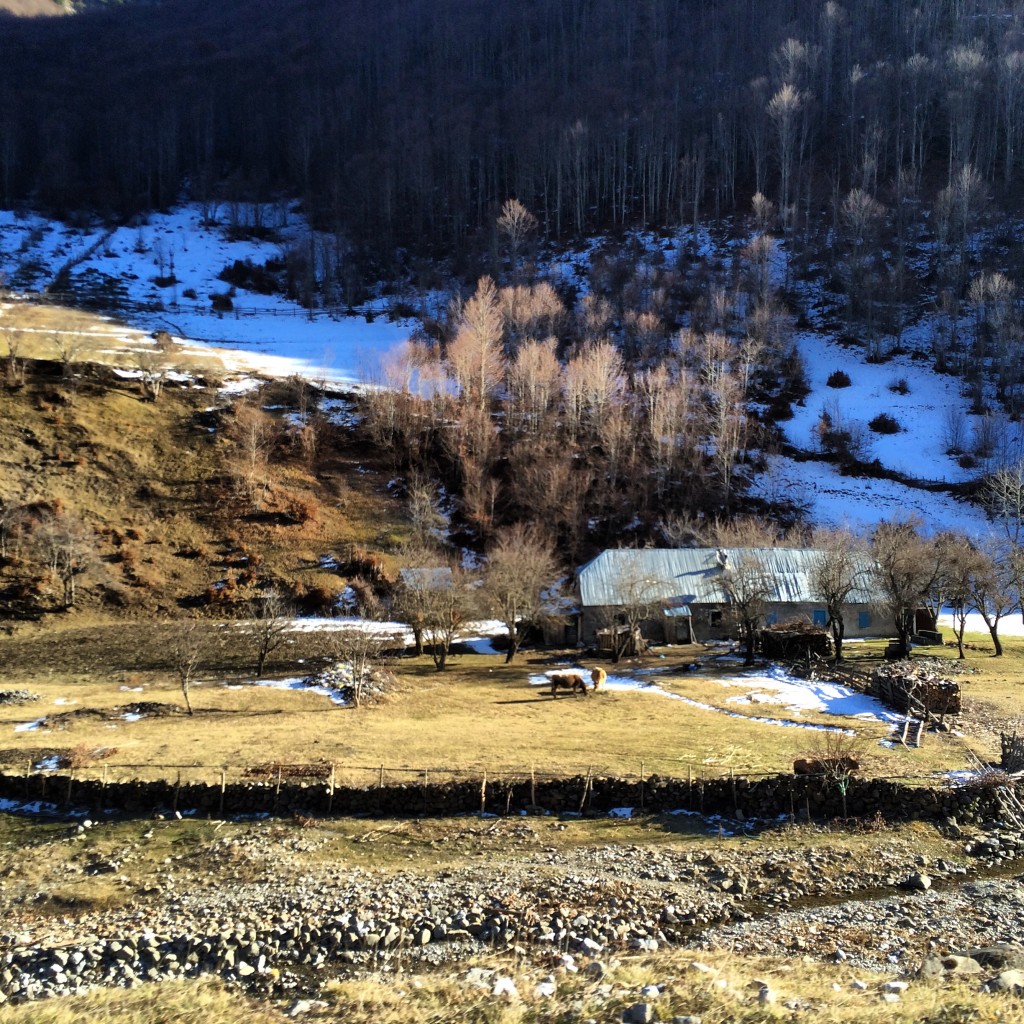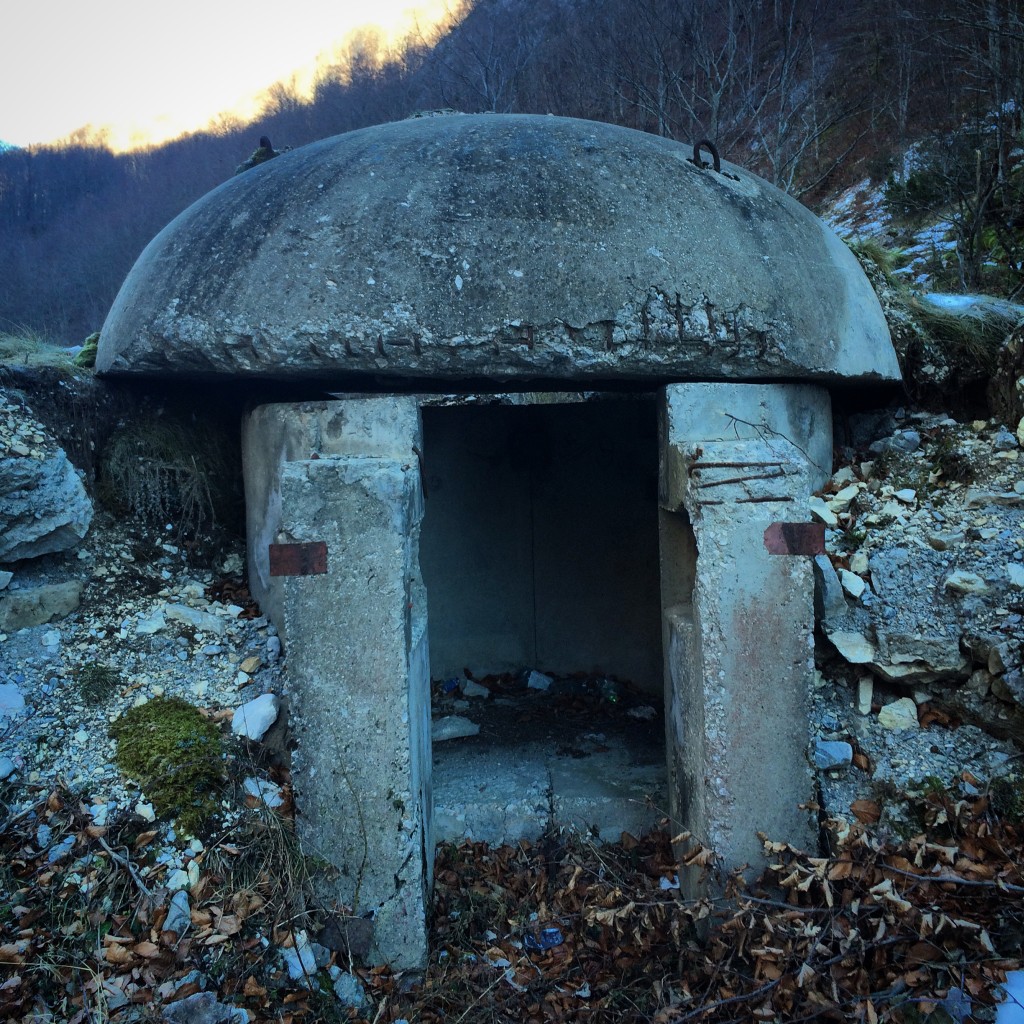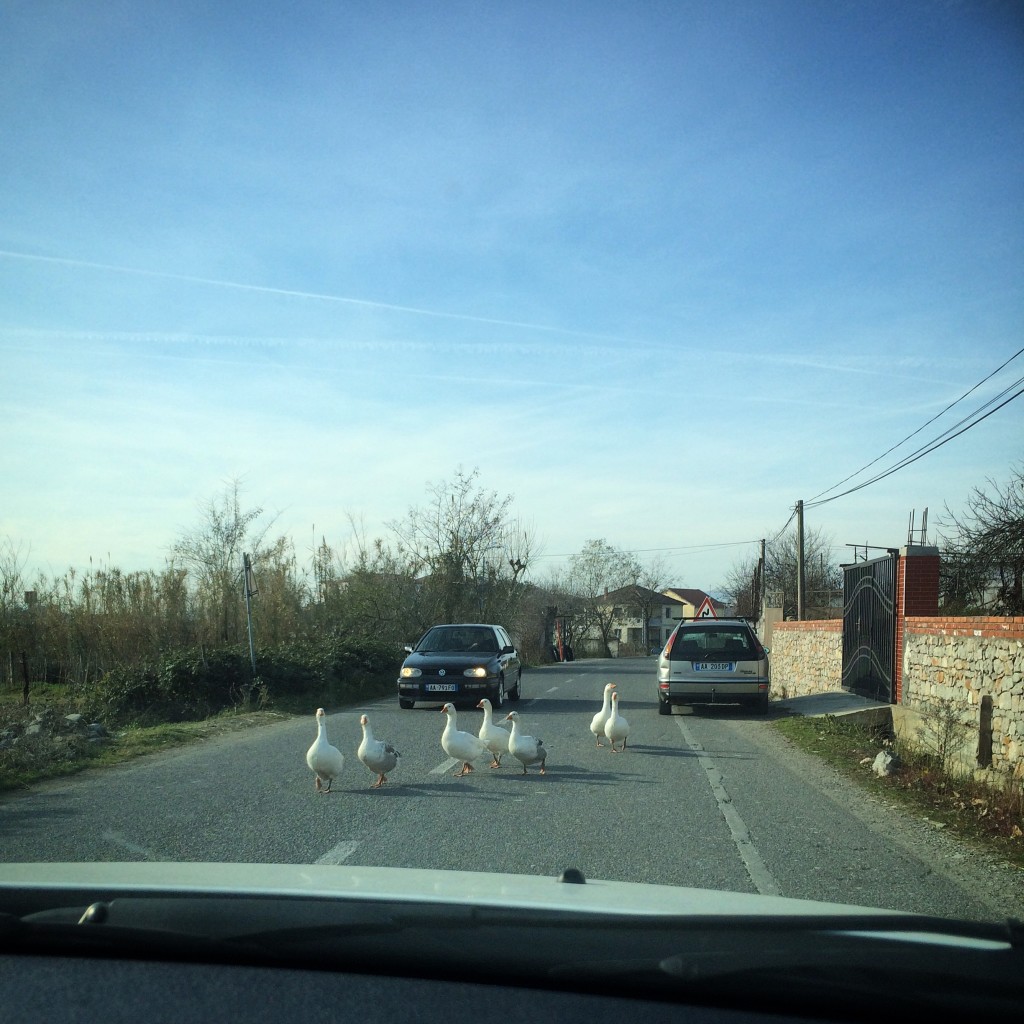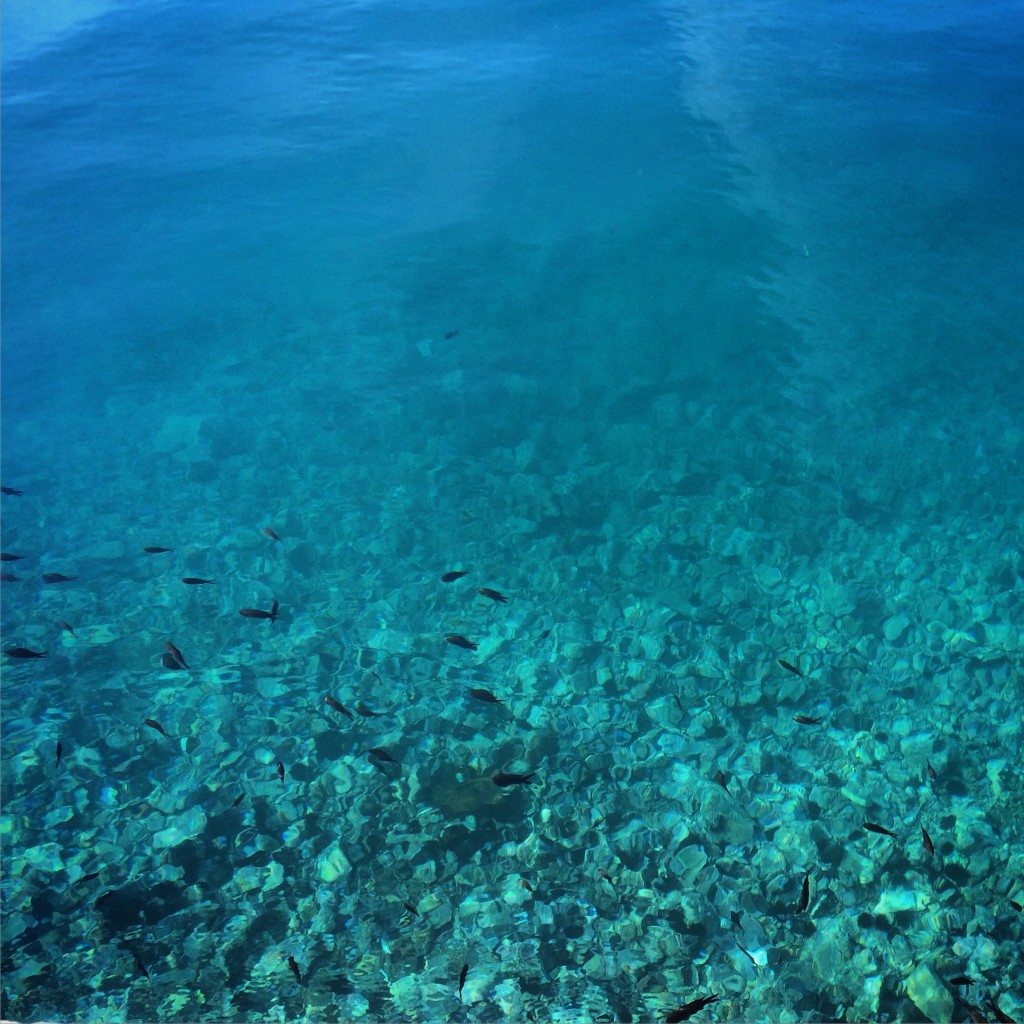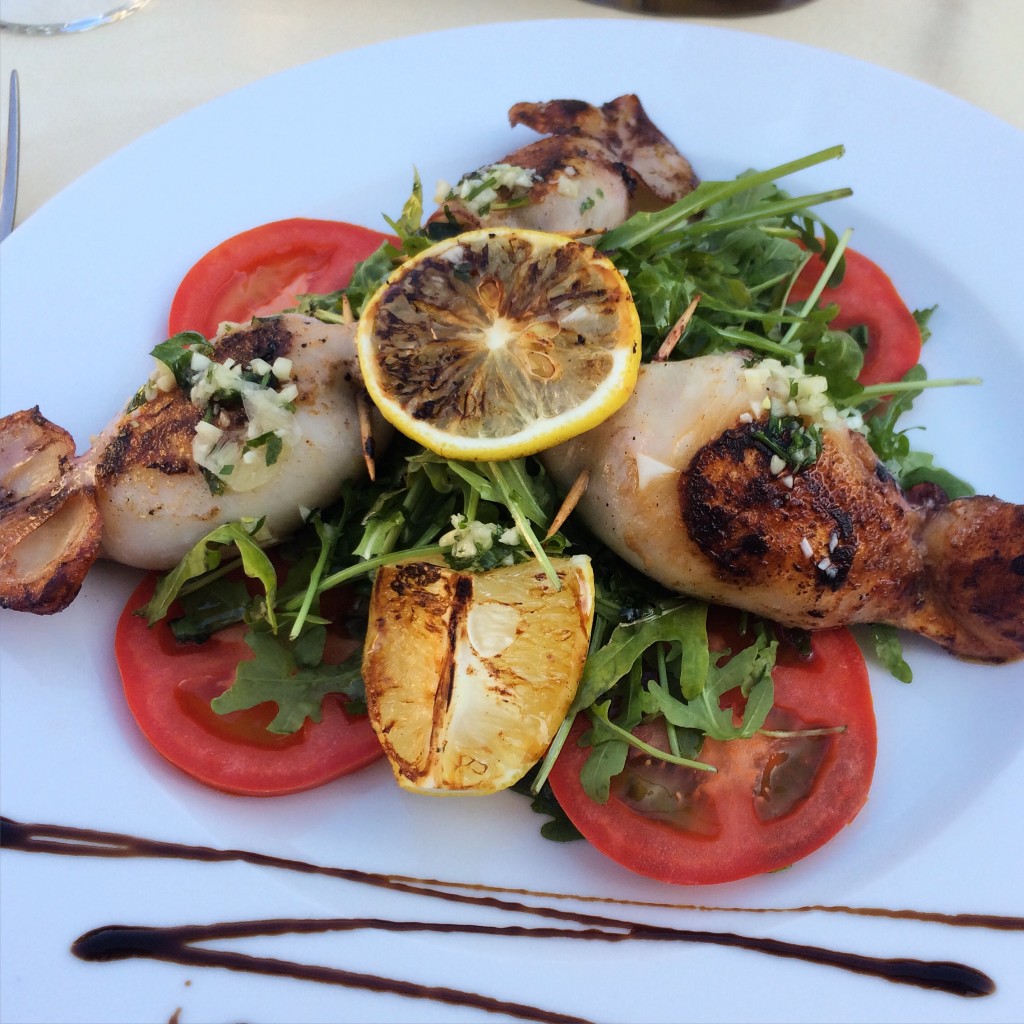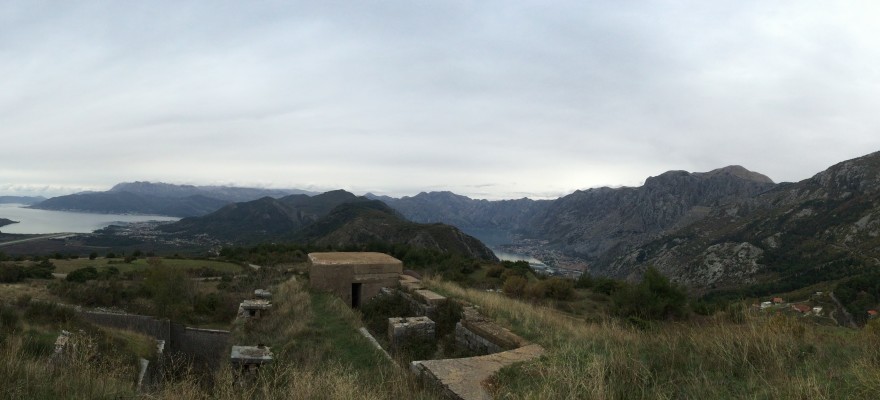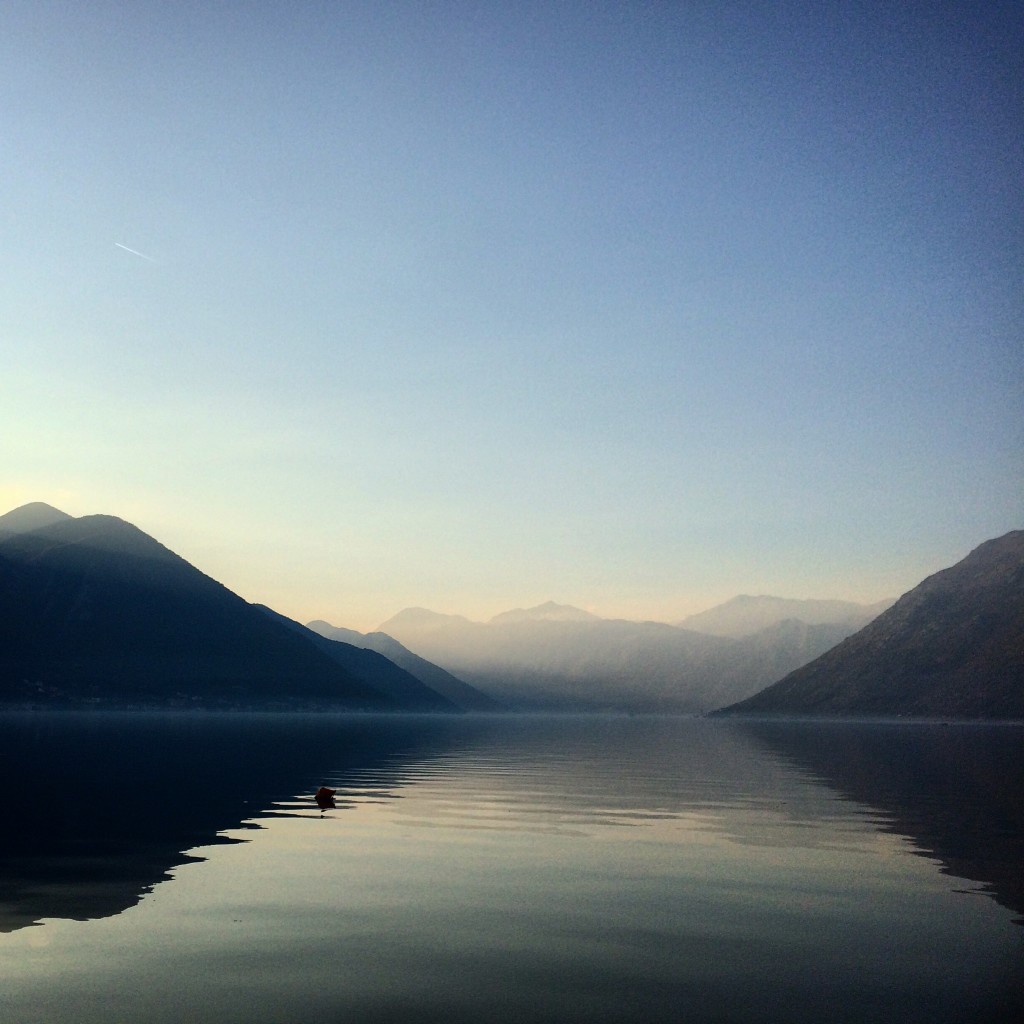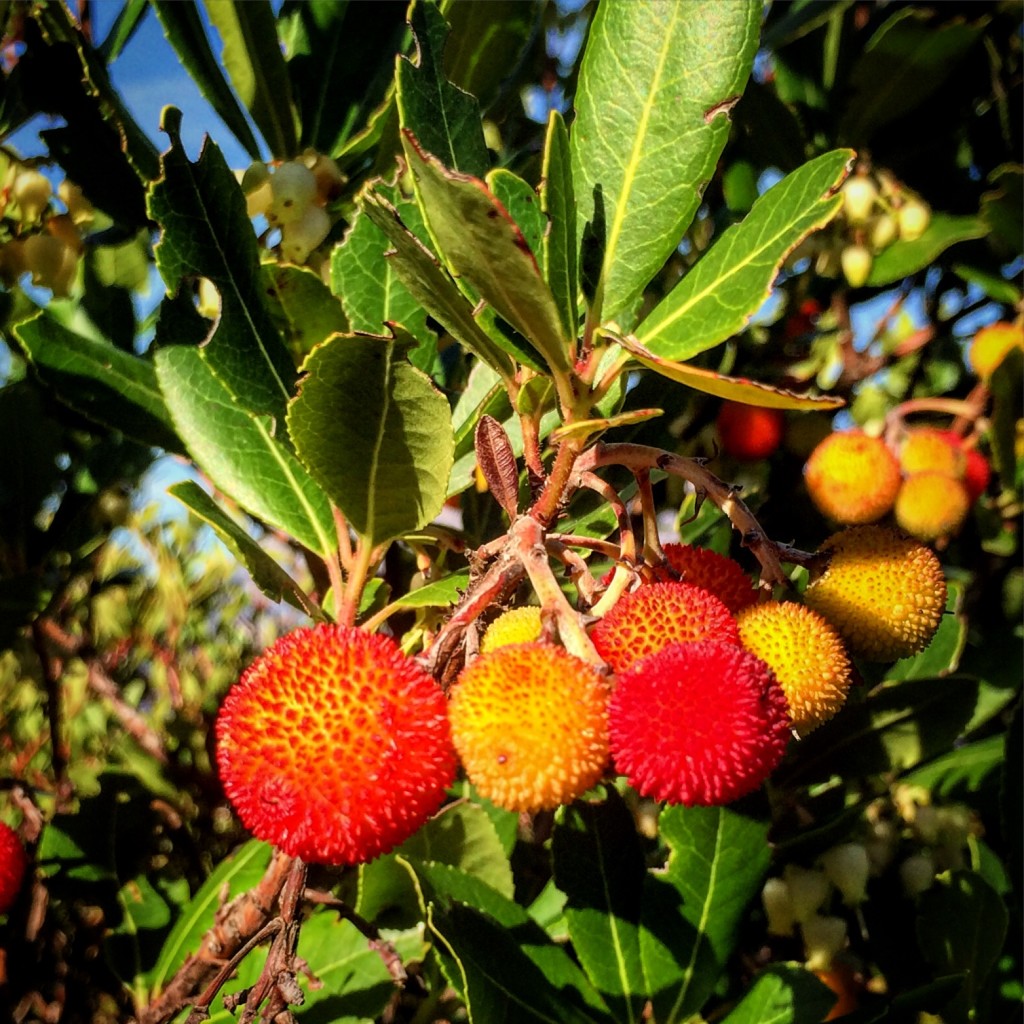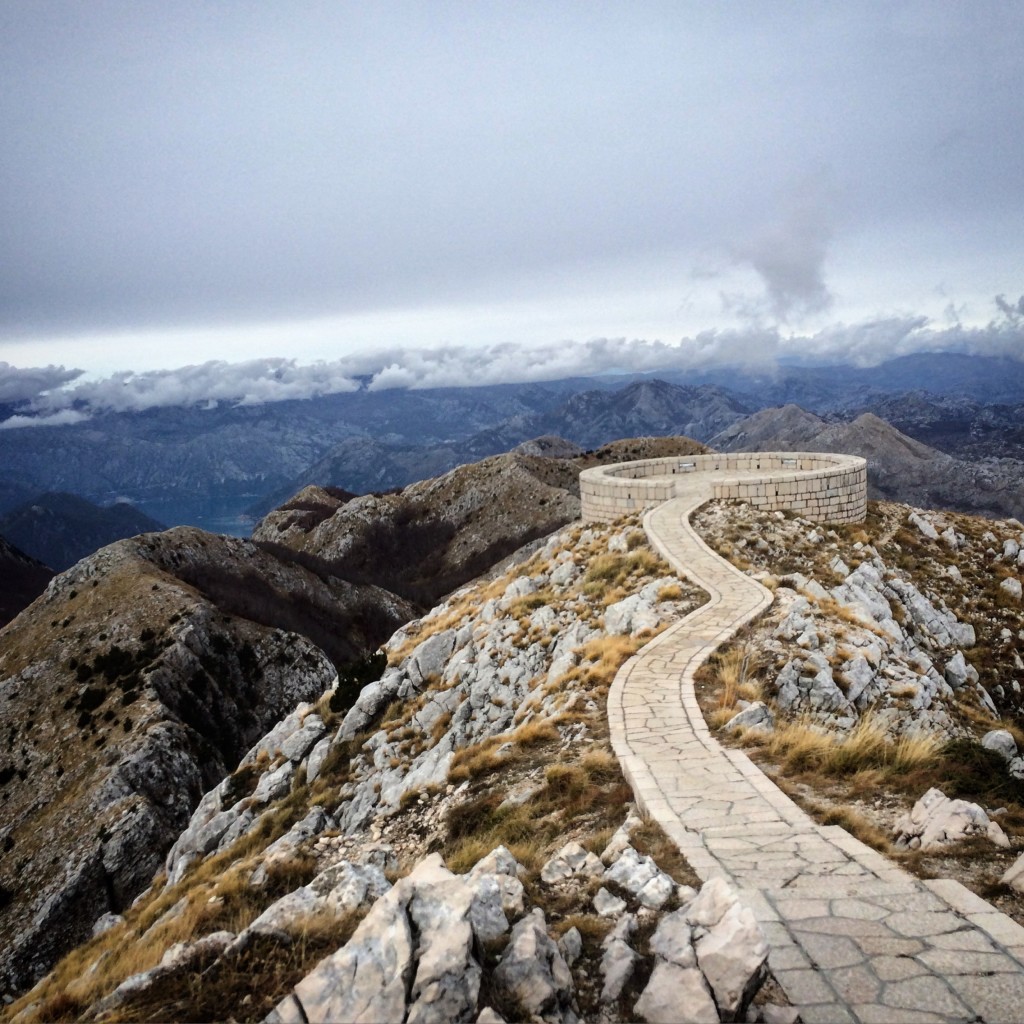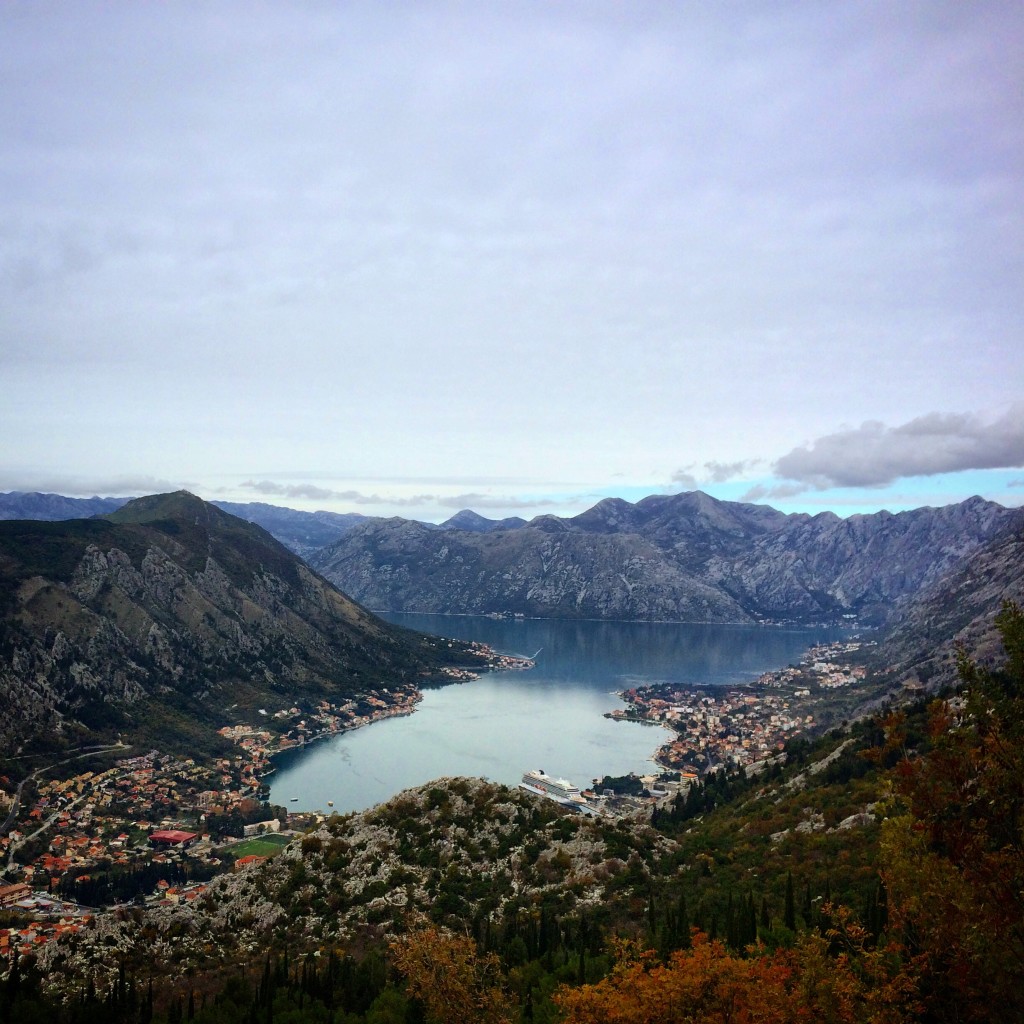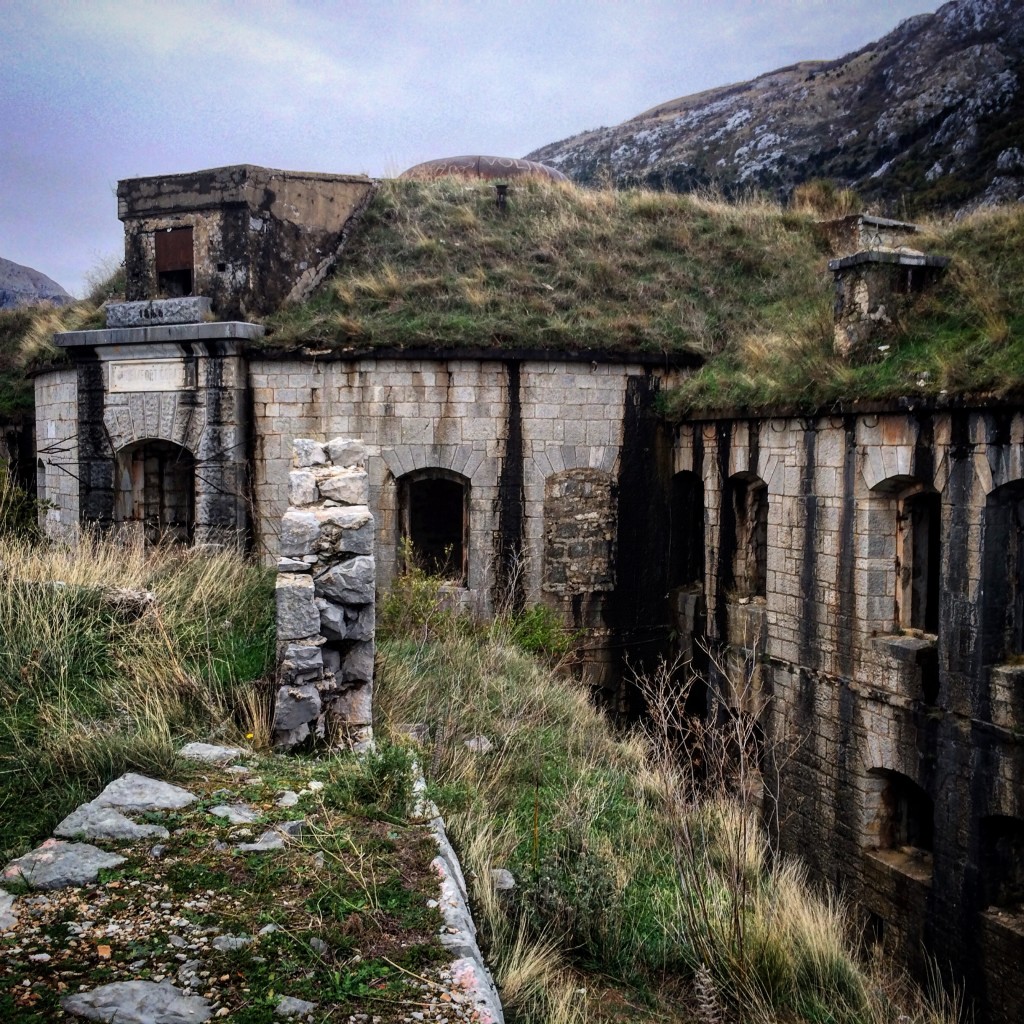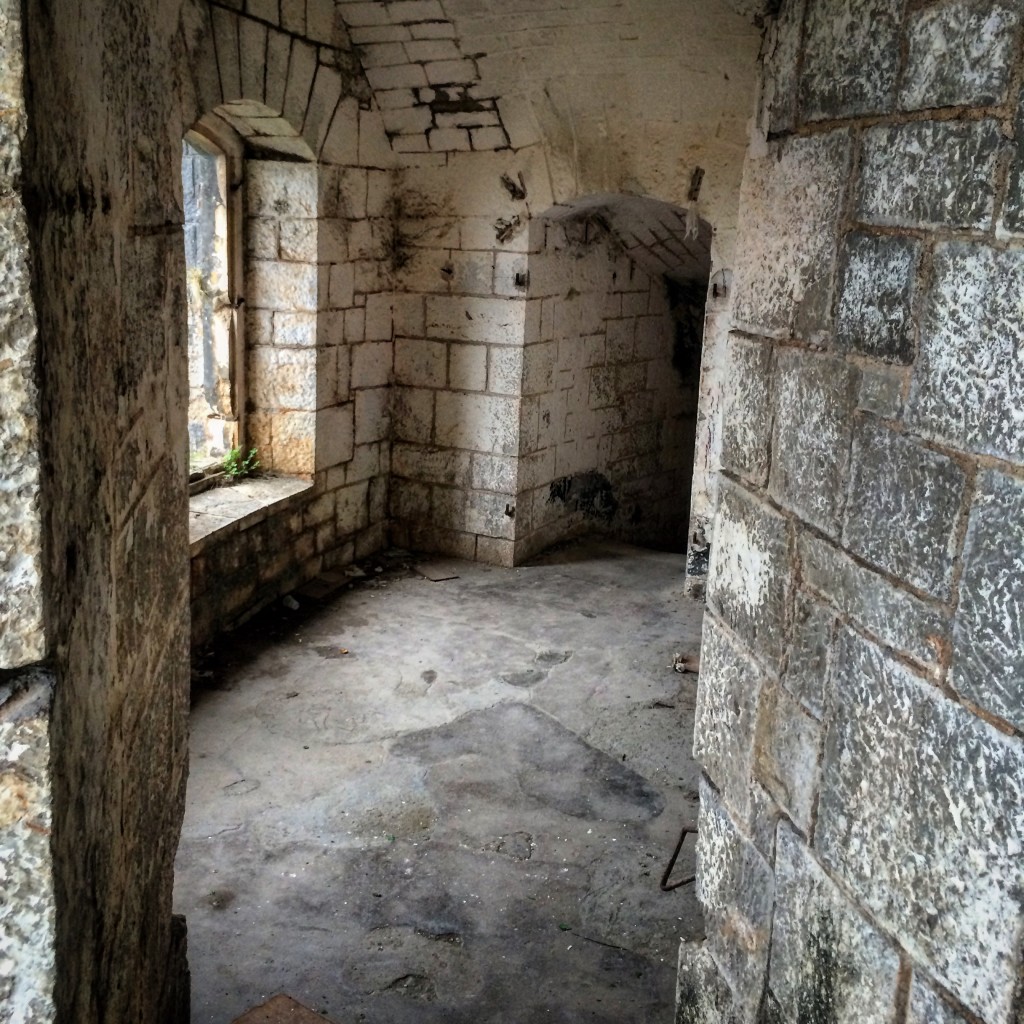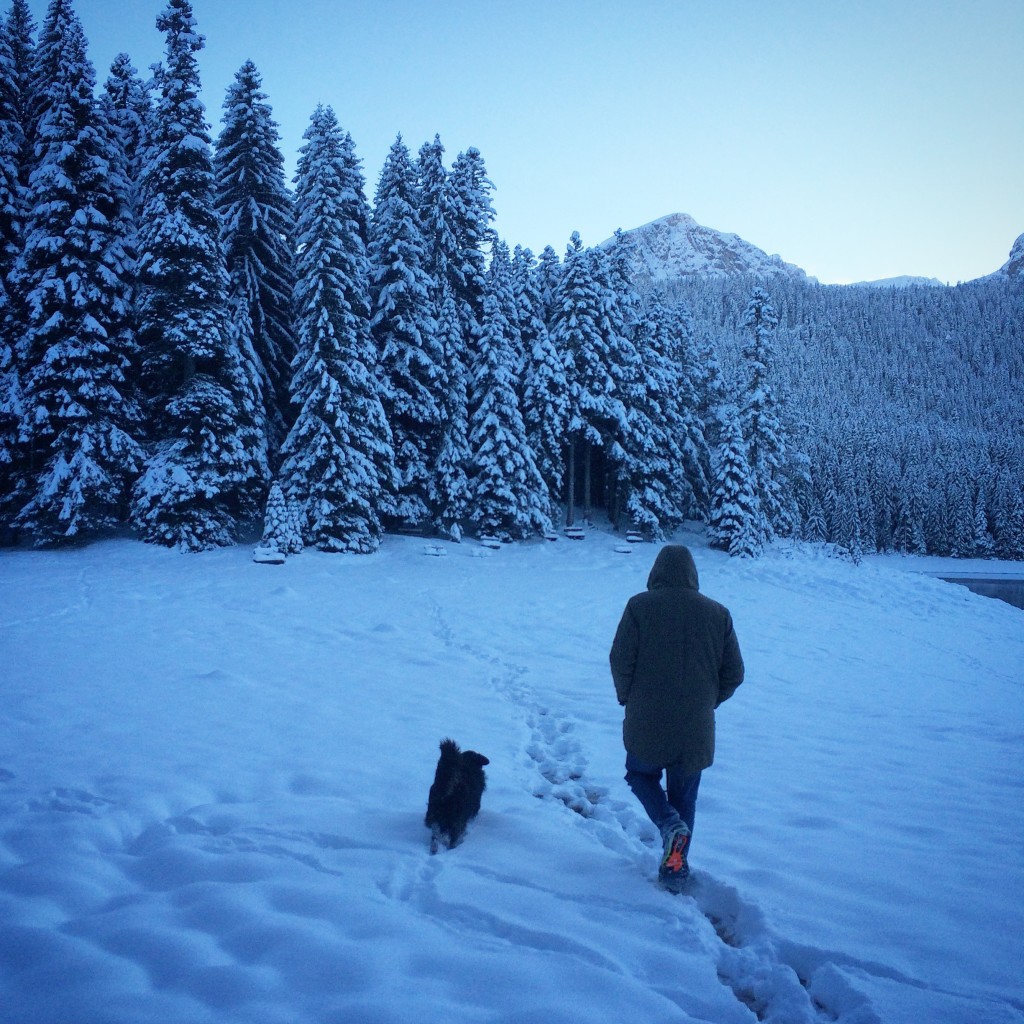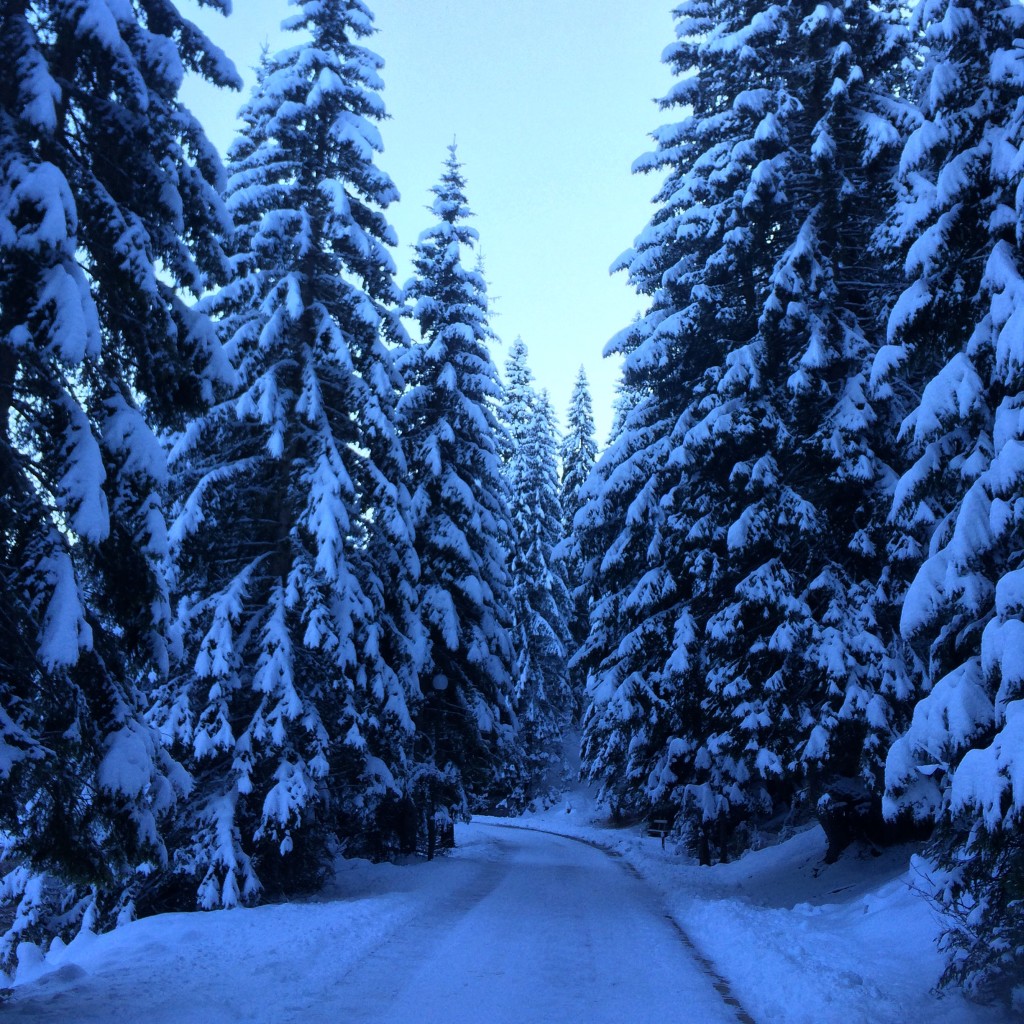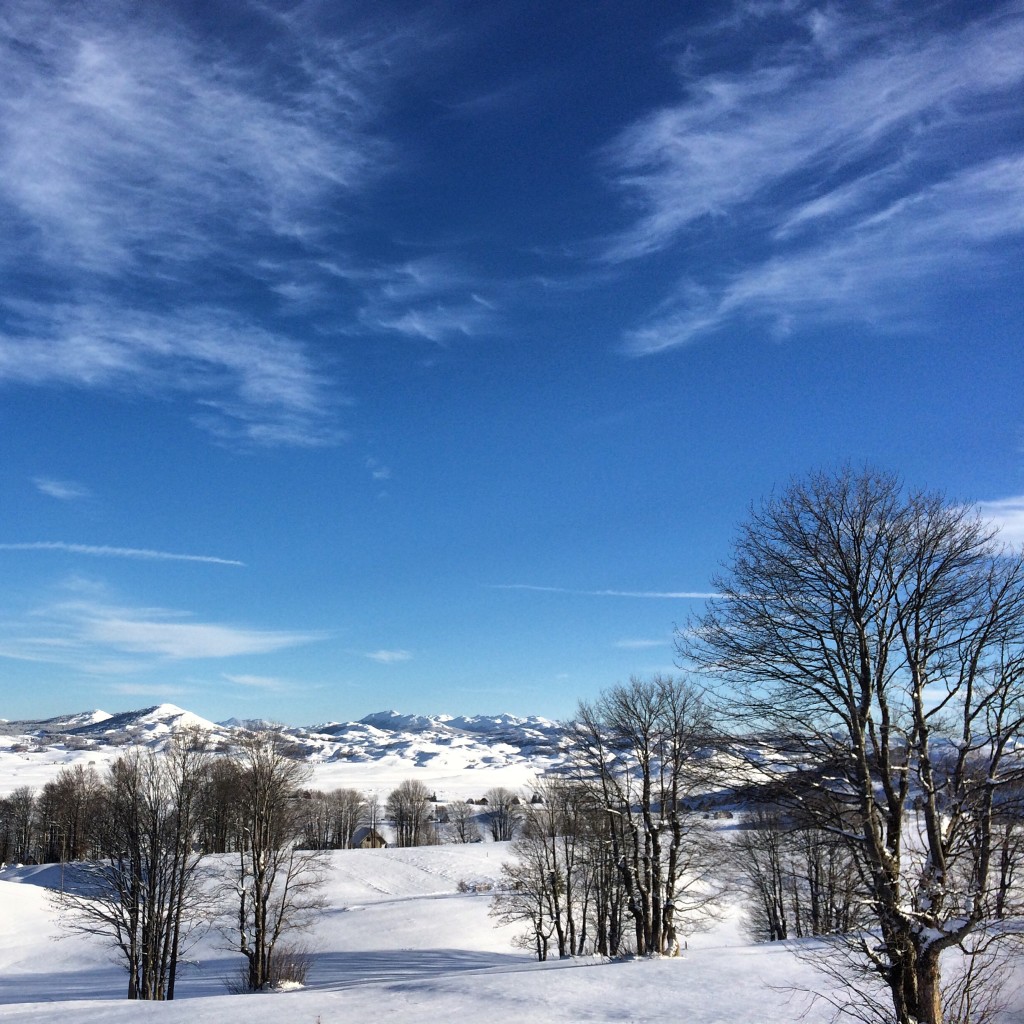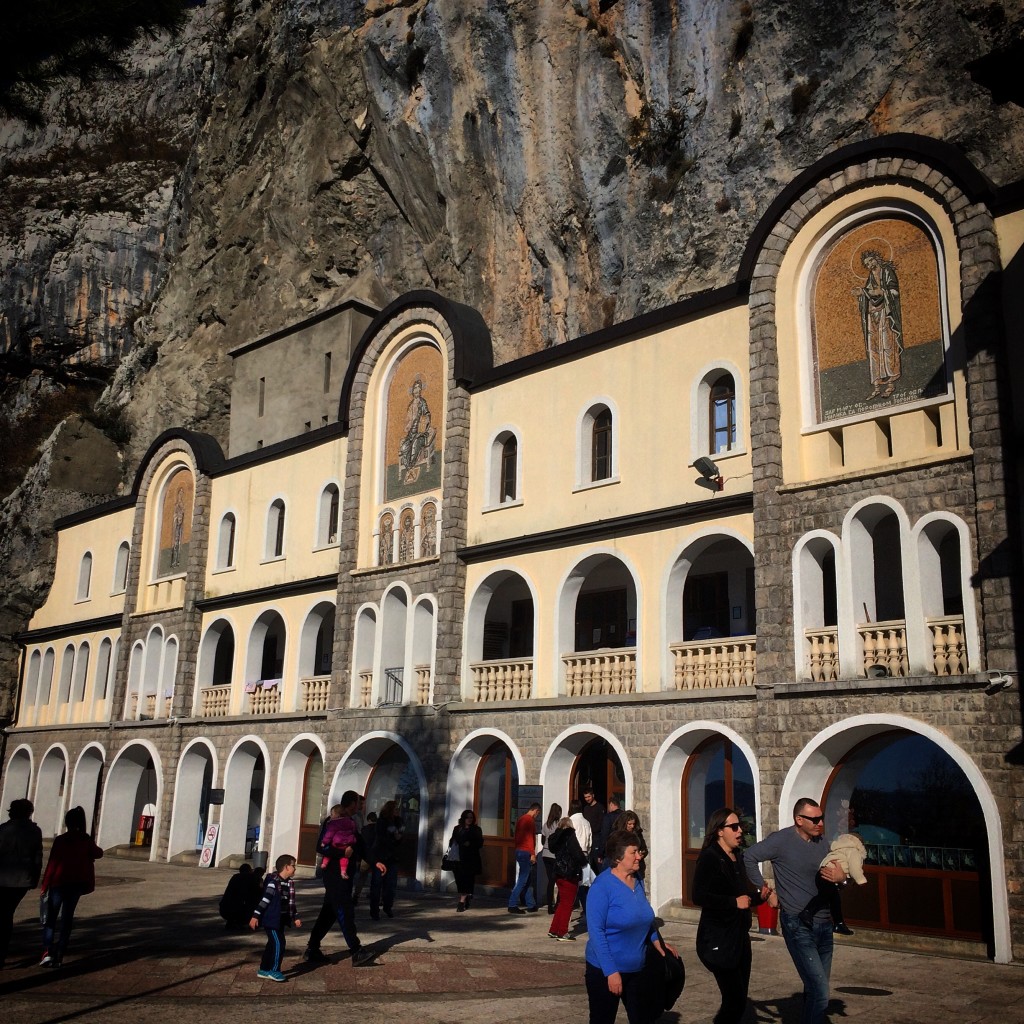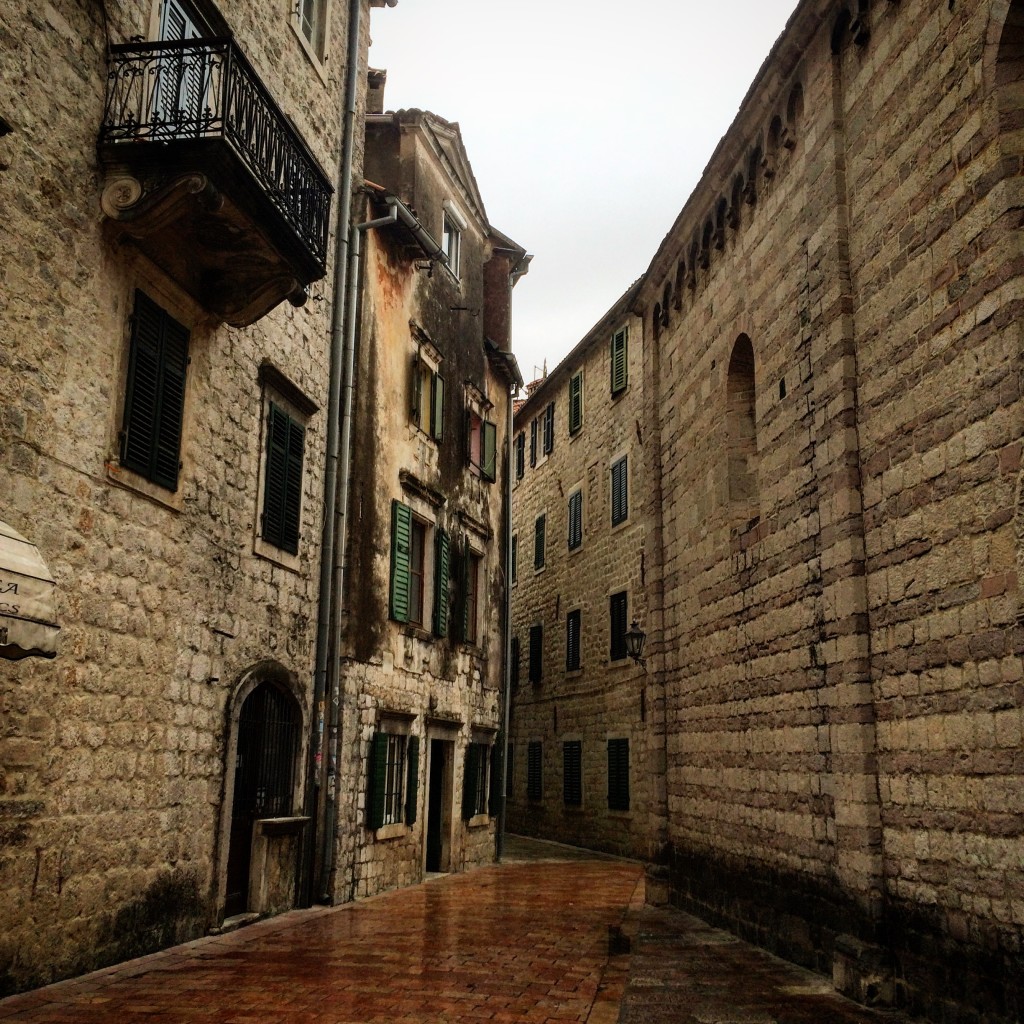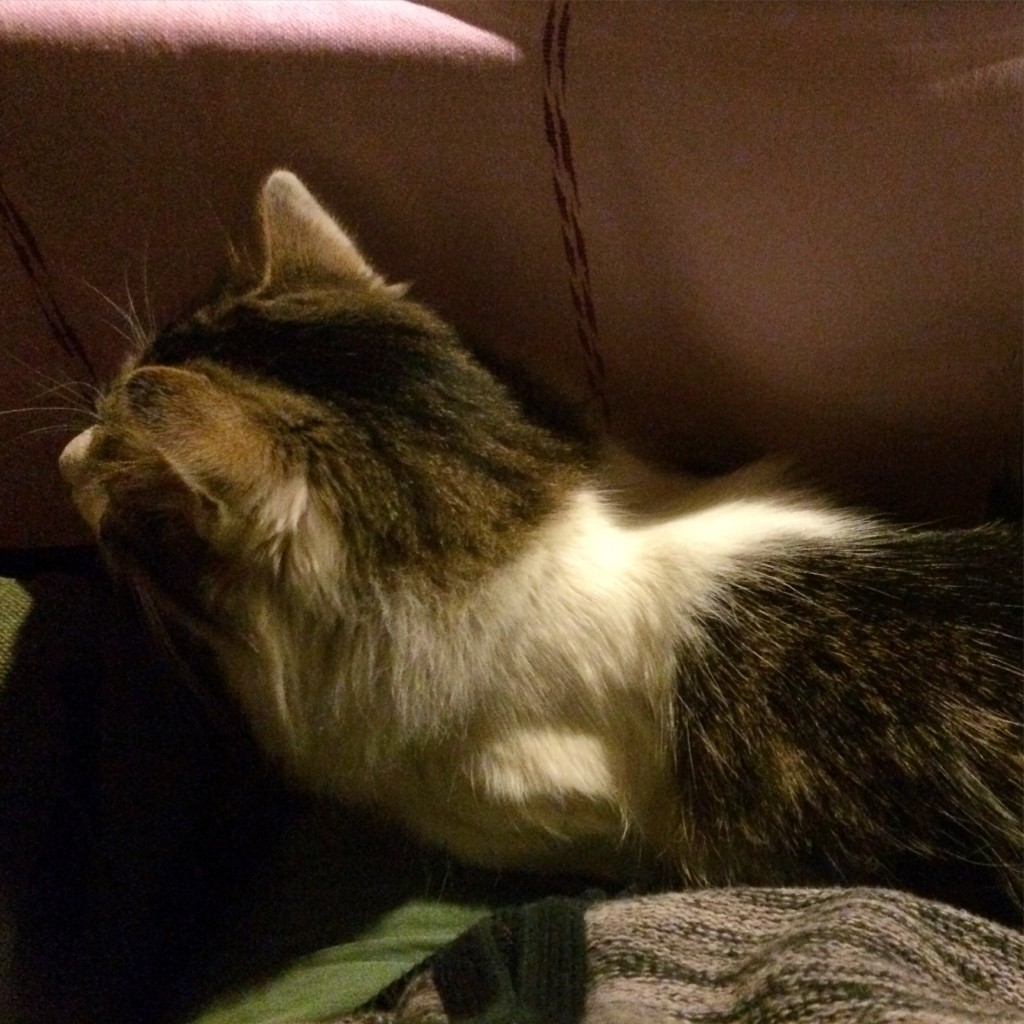The Last Week:
We actually stayed 5 weeks in Montenegro, rather than the customary 4. Because of Schengen. Thanks to reading various horror stories, we didn’t want to risk entering the Schengen early and getting the boot out of Europe. So we took a little bit of extra time to explore Montenegro more thoroughly.
Kolasin:
For our last week in Montenegro we thought we would explore a bit further afield than our previous forays. Given that it had been snowing in the mountainous areas, driving out to the colder parts sounded like it might be fun. Especially since we were suspicious that we might not get any snow in our next stop, Prague. But mostly, the choice of destination was decided because we saw a cottage shaped like a mushroom on the internet and couldn’t resist going and staying at least a night in it. It happened to be in Kolasin, so that’s where we went.
The drive out to Kolasin was all sorts of spectacular, and the mountains and rivers we passed on the way were most impressive. The train line could often be seen in the mountains high above, snaking in and out of the rock through the multitude of tunnels that seem to criss cross the entire mountain range. It definitely looked like it would have been a train ride to remember. Too bad we didn’t have an opportunity to ride it. For anyone going to Montenegro: totally ride the train. Looks awesome, although the train itself looks a little worse for wear. Goes to Belgrade, and for cheap, too. (That was our other option for our last week – going for a quick visit to Serbia.) Even though we didn’t ride the train, the road was quite the adventure in itself. Almost all the roads in Montenegro have been in excellent condition and also pretty scenic, and the highway to Kolasin was no exception. Yet another fantastic drive to add to the Montenegro tally.
The mushroom cottage was awesome. It was every bit as cute as the internet promised (and freaking cheap, which was a plus). Unfortunately, it was located in an area that had not yet really laid down the snow, so it was plenty cold but not in the least bit snowed under like we had hoped. Nevertheless, we had a great stay in the little cottage, and ate at a couple of the local traditional restaurants while we were there as well. (They were fantastic. Traditional-type restaurants with delicious cheap mystery food, what’s not to love?)
Since there was a distinct lack of the white stuff, we ended up driving back out to Durmitor to get a bit more of a snow fix. It wasn’t quite as lovely as the first visit – that time we had been blessed by super-fresh snow that was soft and fluffy and plentiful. Visiting Durmitor the second time around revealed that the snow was looking a little more worse for wear, having been dirtied up and frozen over without any recent fresh snowfall. Still, made for another great day out. Plenty to see, and another road driven on.
Albania:
Albania was one of our last stops on our trip – it was that or Serbia, and we figured it would be more interesting (than Serbia), given that they speak a different language and use different currency etc. compared to Montenegro. Just a quick visit, for a couple of days.
It’s most likely my fault for not researching more thoroughly, but our planned drive through Albania did not pan out quite as expected. My thoughts had been to enter from the northern Montenegrin border crossing and see a good portion of the countryside on our way to Shkoder where we were planning to stay for a couple of days. The northern corner of Albania features some very beautiful mountains and the national park there definitely looked like it would be worthy of a visit, hence the decision to enter the country from over that way. We nearly chose to enter via Kosovo, but decided that might be too dangerous, since it has an amber warning regarding visitor safety. So..Um. Safety first? However, in retrospect, I’m not sure if it might have actually been a better choice.
Although it appears as a major road on Google Maps, it turns out the road into Albania from the north isn’t a sealed road. Or at least, part of it is sealed, but the first 30km or so of the road from the border isn’t. We basically crossed over the border from fabulous mint-condition sealed road in Montenegro to well manicured (but dirt) road on the other side. Initially we panicked, but it was good dirt road and it wasn’t much further before sealed road resumed. But that didn’t last long either, and before long we found our turn off to Shkoder: a poor quality 4×4 dirt road. We thought this was perhaps an anomaly, and that better road would resume like before. We persisted for a while (probably too long a while), and discovered that it didn’t. Thanks Google Maps for the heads up (not). I would have loved to have kept driving (but in a 4×4), as the area was very beautiful, with beautiful mountains, rivers, farms (with sheep monopolising the road) and curiously enough: a plethora of bunkers. (Seriously, bunkers everywhere. Must have been a hotly contested spot, back in the day.)
It was quite the adventure, but I am very glad we turned around. I’m fairly sure if we had persisted that it would have ended up in a sorry state of affairs in the middle of rural Albanian nowhere. As it was, Murray got out a few times to re-engineer the road somewhat to navigate some of the worse loose road and potholes. Did I mention that the road was also frozen? We gave up when we discovered that further along the road was not only dirt & potholed but at higher elevations also frozen and covered in ice. Turning back meant an extra 4 hours or so of driving in order to get to the next border crossing, but as it happened, the road we took was beautiful and a totally worthwhile drive. (Also, about 1000x safer.)
I’m pretty sure the border control people thought we were a couple of idiots. However, they could have <at any time> thought to mention that our car was not going to be suitable for driving through the Albanian countryside. When we drove (sheepishly) back through the crossing the Albanian official didn’t even bother with our passports, but just let us through with a cheeky smile. I get the impression that we probably weren’t the first tourists to make that mistake (and yet they let us make it anyway). Driving conditions aside, it was totally worth the mistake, since the rest of the driving we did through Albania (when we eventually got there through the western border) was rather uninteresting and bland. Plus we got to see all the crazy bunkers. We didn’t see a single bunker in the rest of the time we were in Albania, and it’s apparently one of the things the country is known for (tourist information recommends you purchase a bunker-shaped ashtray as a souvenir of your visit).
So, when we eventually got to our destination in Shkoder it was well after dark. We more or less ate an early dinner and crashed, we were so tired (although we stuck around for the live entertainment, since it was so good). Our hotel was a traditional-styled old stone building with rooms and the restaurant all decorated to suit. It was quite charming. We stayed there for a couple of days and explored the city on foot. Turned out that Shkoder wasn’t terribly exciting, but we did manage to see a good portion of the city. It seemed like there were mosques on every corner, and the call to prayer was exotic, but pervasive. There were just as many churches, but they weren’t quite as obvious without the broadcasted call to prayer announcing their presence.
Given our limited time, our only Albanian day trip was out to Rozafa fortress, since no trip to any country is complete without visiting yet another castle. It’s quite interesting really – each country has been a bit different, with unique architecture for the castles and churches everywhere we have been. In the morning, we found that there was a wedding being held at our hotel, and we were parked in (a seriously common outcome, it seems), so although we had planned to drive, we ventured out to Rozafa fortress on foot and spent most of the day wandering around the fortress and surrounds. As per usual, we got in a whole lot of exercise for our day out and about (I’m surprised my Nikes have survived so far, but they are definitely due to be retired). Seeing the living conditions of everyday Albanians was quite the eye-opener. Some parts of Shkoder were quite run-down and dirty, although at the same time quite cheerful. It seemed that every second building had birdcages above the lintel of the doorways with budgerigars and other singing birds making the busy city sound like a trip out in the countryside. Even shopfronts sported birds in cages. I really should have asked someone what’s up with all the birds.
Traffic in Albania was nuts. Very much an anything-goes vibe. Like Montenegro, but even more exotic, it seems like people park on just about any surface that would accommodate a vehicle. In two days, our car was parked-in repeatedly. We also saw plenty of driving that would be considered not cool at home (sometimes in rather unconventional vehicles), but then again, we have seen a lot of seriously weird driving behaviour since leaving home in March. Interestingly, in Albania it seems like everyone owns a Mercedes. Given the larger amount of poorer housing, the car situation seems rather unusual.
The real highlight of our Shkoder visit was enjoying the traditional wood-fired Albanian food & music at our hotel. Although I wouldn’t normally suggest going to the same place twice, our experience was that good that we went back for more. Our hotel also had breakfast included, so that was interesting, trying out what has to be the most bizarre breakfast we have eaten thus far. Three kinds of local preserves, savoury yoghurt, olives, tomatoes, feta-like cheese, eggs and fresh bread cooked on the hearth. Peculiar, but delicious.
We weren’t in Albania for long, but it was an interesting visit, and I’m glad we made the effort to at least see a small portion of the country.
Podgorica:
Well. We spent our last couple of days here. Podgorica is the capital of Montenegro, and although rather much larger than other cities in the country, it certainly is not particularly pretty. However, we decided it would be worth visiting, and our visit turned out to be pretty good, ugly city or no. Our apartment was both cheap and pretty flash, and in a good location, too: across the road from a traditional restaurant, a burger joint (that sells burgers for the equivalent of $1) and a <wait for it> a craft beer shop. (Murray was very excited.)
Unlike the coastal places we had been to, the Podgorica Old Town was thoroughly unremarkable, and in a sad state of affairs. Covered in graffiti and rubbish, it was by far the least attractive of all the old-city locations we visited. Fortunately, the rest of the city was not in as bad shape. We discovered that food was even cheaper in Podgorica than in Kotor, and the traditional restaurant nearby was fabulous. Even had live traditional music. As usual, the amount of food served was close to Texan-proportions. Montenegrin restaurants sure know how to feed you well.
We also found a craft beer bar, and visited for a drink or two before dinner one night. This was pretty exciting, given we hadn’t seen anything approximating decent beer for the entire month. At the bar we met a priest from the orthodox church and his english speaking theology student, and proceeded to have quite an interesting (and extended) conversation about beer, religion and life in general. Our quick stop ended up being quite a long one… They were also the first to inform us that Podgorica is said Pod-gor-it-sa, which was a fine thing to discover at the very end of our trip to Montenegro. (We had been saying Pod-gor-ick-a). You would think that someone might have corrected us before now, however, nope. At any rate, meeting the two of them made for a great last night out in Montenegro.
Weather in Winter:
When we arrived we were fortunate to catch a last little slice of indian summer. Considerably warmer than our stay in Italy, our first experience of Montenegro was of balmy pseudo-summer days and sunny, clear skies. Of course, this was not the norm, and thusly, did not last. We tried to make the most of it, and although to my feeling it seemed plenty warm enough to go swimming, the few people we did see at the beaches were sunning themselves instead.
Aside from the summery weather we were initially treated to, the days were often overcast or wet. This was the weather we had been expecting, with shorter winter daylight hours (especially so, with the mountains stealing the sun early) and sometimes ridiculously strong winds to go with the wet, gloomy weather. Some days had strong enough winds to knock you sideways. However, we were fortunate enough to have enough days with good weather to make most of the trips out and about a success.
Strange Food:
Everywhere we go, the food is different. In Montenegro, the oddest thing we noticed was that there appears to be a distinct love affair with dog-roll. Well…not dog-roll exactly, but Strasburg-esque processed mystery meats in various flavours and sizes. It was everywhere. At the butcher, there was more of the mystery meat than real meat (vying for space with the vast quantities of smoked meat products, another clear favourite).
Montenegrin “Beaches”:
Montenegrin coastline looks beautiful, but the beaches are pebbly at best. Sometimes (frequently) the water is inaccessible or entirely made of concrete. The “beaches” we saw did not fit my preformed notions of what a beach should look and feel like. Plus their beaches come with copious servings of sea urchins, adding a new precarious twist to the swimming experience (much like Croatia, entering the water is probably a task best achieved with sturdy footwear). Perhaps it’s a side effect of growing up in Australia, but it seems like all the “beautiful pristine beaches” we have read about barely hold a candle to the beaches at home. The biggest difference was the abundance of beautiful blue clear waters. In the rivers and at the beach, the water here was definitely the envy of anything at home. If I had a wetsuit, I would have been in it for sure.
Free Liquor:
Shots. Everywhere we go it seems people give us shots. Not naturally a consumer of anything in a shot-glass, this has been somewhat perplexing. (If I’m having a glass of wine or a beer, why give me a shot? …My explanation is that I guess that’s the more common home-brew in Europe.) Restaurants and bars worldwide have with frequency given us complimentary shots of local liquor. Some of which proved delicious, others much less so (some closer to truly horrendous – thanks Bosnia). It’s a nice touch, offering complimentary liquor, but it’s certainly never happened to me at home.
Food Shopping:
Don’t get me started. Montenegro was far and away the worst country we have been to in terms of shopping for daily needs. I guess it wasn’t necessarily bad, but it was very limited in range. Their vegetables were very sad. (The only non-wilted veg were zucchini, cabbage and eggplant, so we ate that pretty much every day. I ate more cabbage in 4 weeks than I have in the last 4 years, and it’s not as if I don’t like cabbage.) Meat was a job for the butcher, and the butchers we met didn’t speak english. So it was a case of point and shoot (and hope for the best). Almost nothing was pre-cut (the main exception being chicken in odd cuts), and there was nothing prepackaged. It made food shopping for the month rather exotic. While trying to navigate the whole ordering meat situation I did, however, get to see one of the butchers haul a quarter of a cow onto a work bench by himself. It looked like some seriously hard work. Somehow, he turns cows into steak and whatnot just with a butchers cleaver. It certainly explained why all the meat cuts in general looked pretty ragged everywhere we went. (I’m guessing a powered blade is not in general use in these parts.)
On the plus side, the food (much like everything else in Montenegro) was seriously cheap. $5 for almost a kilo slab of good quality t-bone. That’s impressive. However, we weren’t able to eat A-grade steak everyday, as we had to rely on there being steak cut and ready to go (since we had no way of communicating that we would like a cut of meat – the Serbo-Croatian language guides don’t really cover how to ask the butcher for things). Plus their cuts of meat are significantly different and look rather unfamiliar when still attached to a solid amount of cow or pig.
We lived on mince, chicken wings, ham hocks, T-bone and sea bass. Plus copious amounts of cabbage and zucchini.
Sea Bass and other delicious Things from the Sea:
Seafood in Montenegro was awesome. I was hoping as much, and it delivered. Much like Croatia, coastal Montenegrin restaurants often specialise in grilled fish, octopus and squid (and grilled meats – like Romania, they love their chevaps). We ate out a couple of times and enjoyed some seriously delicious grilled fish before we decided maybe we should have a crack at home. We had been told that there was a seafood shop near us called Cogimar that our host recommended. So we went and discovered plenty of cheap super-fresh fish from the fanciest seafood vendor I’ve ever seen. If you’re ever in Kotor – check out Cogimar. That’s some seriously fancy digs. The place primarily sells fresh & live seafood, but also has fine wine, deli goods, cigars (seriously, what kind of fishmonger sells cigars???)…and has no fish smell whatsoever. I’m guessing the fact that everything is fresh & they don’t gut or fillet any of the fish explains the lack fishy fragrance. That, or some sort of voodoo magic. The fishmonger wouldn’t gut the fish for me, but was happy to explain how…So thanks to him (and YouTube) I am now reasonably proficient at preparing fish. (For the purposes of grilling whole, anyways.) Turned out grilling fish is not particularly difficult. As a result, there were quite a few <$5 AUD seafood dinners at home.
The other plus about visiting Cogimar was seeing all the kitties camped out at the entrance to the store. Seriously cute. I guess they like the fish shop, too.
On visiting Montenegro:
Our trip to Montenegro turned out to be a far better experience than anticipated. I had thought traveling in low-season might mean our trip would be bland, but it certainly was not. If anything, we discovered Montenegro to be a fantastic country to visit, with plenty of merit to visiting in the colder months. The facilities might be a bit basic, perhaps, and plenty of things might be closed during the off-season but Montenegro is still a very beautiful country with many wonderful things to see. Given that we did see quite a lot of it, I guess it is unlikely we would return, but this would certainly be an excellent place to visit during the warmer months when the water is warm enough to enjoy. I’d certainly recommend it to anyone thinking about visiting, irrespective of the season. Plus, it was a super-cheap destination – a definite plus when touring Europe.
